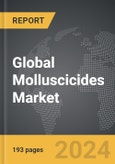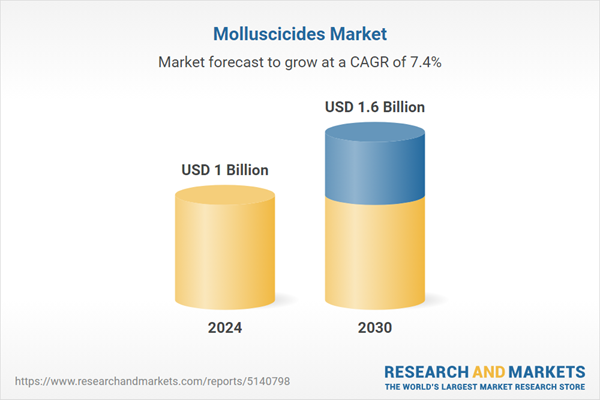The global market for Molluscicides was valued at US$1.0 Billion in 2024 and is projected to reach US$1.6 Billion by 2030, growing at a CAGR of 7.4% from 2024 to 2030. This comprehensive report provides an in-depth analysis of market trends, drivers, and forecasts, helping you make informed business decisions. The report includes the most recent global tariff developments and how they impact the Molluscicides market.
Segments: Type (Chemical Molluscicides, Biological Molluscicides); Form (Pellets, Liquids & Gels); Application (Agricultural, Non-Agricultural).
Geographic Regions/Countries: World; United States; Canada; Japan; China; Europe (France; Germany; Italy; United Kingdom; Spain; Russia; and Rest of Europe); Asia-Pacific (Australia; India; South Korea; and Rest of Asia-Pacific); Latin America (Argentina; Brazil; Mexico; and Rest of Latin America); Middle East (Iran; Israel; Saudi Arabia; United Arab Emirates; and Rest of Middle East); and Africa.
The analysts continuously track trade developments worldwide, drawing insights from leading global economists and over 200 industry and policy institutions, including think tanks, trade organizations, and national economic advisory bodies. This intelligence is integrated into forecasting models to provide timely, data-driven analysis of emerging risks and opportunities.
Global Molluscicide Market - Key Trends & Drivers Summarized
What Are Molluscicides and Why Are They Important?
Molluscicides, commonly known as snail baits or slug pellets, are chemical substances or biological agents used to control or kill molluscs, particularly slugs and snails that pose significant threats to agricultural crops and garden plants. These pests are notorious for their ability to damage a wide range of vegetation through their feeding activities, leading to substantial economic losses in the agricultural sector. Molluscicides come in various forms, including granules, liquid sprays, and pellets, each tailored to suit different environmental conditions and application methods. Their primary function is to ensure crop safety by eliminating molluscs from fields and gardens, thus enhancing the quality and quantity of agricultural output.How Does the Market Respond to Environmental Concerns and Regulatory Changes?
The development and use of molluscicides have been significantly influenced by growing environmental concerns and stringent regulations aimed at reducing the ecological impact of agricultural chemicals. Innovations in the formulation of molluscicides now focus on reducing harm to non-target species and minimizing chemical residues in crops and soils. Biodegradable and organic molluscicides are gaining traction, reflecting an industry shift towards sustainability. Regulatory bodies across the globe have implemented strict guidelines governing the application of chemical pesticides, including molluscicides, which has spurred the development of safer, more environmentally friendly alternatives. These changes are reshaping market dynamics, with an increasing number of manufacturers investing in eco-friendly products to comply with regulatory standards and meet consumer preferences for sustainable agricultural practices.What Role Do Technological Advancements Play in Shaping Market Preferences?
Advancements in agricultural technologies have paved the way for the integration of molluscicides with precision farming techniques. The adoption of drone technology and GPS-guided application systems allows for the precise distribution of molluscicides over large agricultural areas, thereby optimizing their effectiveness and reducing waste. Additionally, the rise in the use of integrated pest management (IPM) strategies, which include biological control methods alongside chemical solutions, is influencing the molluscicide market. These technological integrations not only improve the efficiency of molluscicide usage but also support the trend towards more sustainable farming methodologies that are less dependent on chemical inputs.What Drives the Growth in the Molluscicide Market?
The growth in the molluscicide market is driven by several factors, which together cater to a broad range of agricultural and residential needs. The escalating demand for high-value, sensitive crops such as fruits, vegetables, and ornamental plants necessitates more stringent pest control measures to safeguard these investments. Additionally, urbanization trends and the popularization of home gardening have expanded the consumer base for molluscicides beyond traditional agricultural users to urban dwellers. On the regulatory and technological front, advancements aimed at producing safer, more sustainable molluscicide options are making these products more attractive to environmentally conscious consumers. Together, these elements are pushing forward the molluscicide market, fostering growth through innovation, sustainability, and expanding market reach.Report Scope
The report analyzes the Molluscicides market, presented in terms of units. The analysis covers the key segments and geographic regions outlined below.Segments: Type (Chemical Molluscicides, Biological Molluscicides); Form (Pellets, Liquids & Gels); Application (Agricultural, Non-Agricultural).
Geographic Regions/Countries: World; United States; Canada; Japan; China; Europe (France; Germany; Italy; United Kingdom; Spain; Russia; and Rest of Europe); Asia-Pacific (Australia; India; South Korea; and Rest of Asia-Pacific); Latin America (Argentina; Brazil; Mexico; and Rest of Latin America); Middle East (Iran; Israel; Saudi Arabia; United Arab Emirates; and Rest of Middle East); and Africa.
Key Insights:
- Market Growth: Understand the significant growth trajectory of the Chemical Molluscicides segment, which is expected to reach US$997.3 Million by 2030 with a CAGR of a 6.7%. The Biological Molluscicides segment is also set to grow at 8.6% CAGR over the analysis period.
- Regional Analysis: Gain insights into the U.S. market, valued at $263.6 Million in 2024, and China, forecasted to grow at an impressive 10.9% CAGR to reach $377.6 Million by 2030. Discover growth trends in other key regions, including Japan, Canada, Germany, and the Asia-Pacific.
Why You Should Buy This Report:
- Detailed Market Analysis: Access a thorough analysis of the Global Molluscicides Market, covering all major geographic regions and market segments.
- Competitive Insights: Get an overview of the competitive landscape, including the market presence of major players across different geographies.
- Future Trends and Drivers: Understand the key trends and drivers shaping the future of the Global Molluscicides Market.
- Actionable Insights: Benefit from actionable insights that can help you identify new revenue opportunities and make strategic business decisions.
Key Questions Answered:
- How is the Global Molluscicides Market expected to evolve by 2030?
- What are the main drivers and restraints affecting the market?
- Which market segments will grow the most over the forecast period?
- How will market shares for different regions and segments change by 2030?
- Who are the leading players in the market, and what are their prospects?
Report Features:
- Comprehensive Market Data: Independent analysis of annual sales and market forecasts in US$ Million from 2024 to 2030.
- In-Depth Regional Analysis: Detailed insights into key markets, including the U.S., China, Japan, Canada, Europe, Asia-Pacific, Latin America, Middle East, and Africa.
- Company Profiles: Coverage of players such as ADAMA Agricultural Solutions Ltd., American Vanguard Corporation, BASF SE, Bayer CropScience AG, Certis Europe B.V. and more.
- Complimentary Updates: Receive free report updates for one year to keep you informed of the latest market developments.
Some of the 44 companies featured in this Molluscicides market report include:
- ADAMA Agricultural Solutions Ltd.
- American Vanguard Corporation
- BASF SE
- Bayer CropScience AG
- Certis Europe B.V.
- De Sangosse
- Doff Portland Limited
- Lonza Group AG
- Marrone Bio Innovations, Inc.
- W. Neudorff GmbH KG
Tariff Impact Analysis: Key Insights for 2025
Global tariff negotiations across 180+ countries are reshaping supply chains, costs, and competitiveness. This report reflects the latest developments as of April 2025 and incorporates forward-looking insights into the market outlook.The analysts continuously track trade developments worldwide, drawing insights from leading global economists and over 200 industry and policy institutions, including think tanks, trade organizations, and national economic advisory bodies. This intelligence is integrated into forecasting models to provide timely, data-driven analysis of emerging risks and opportunities.
What’s Included in This Edition:
- Tariff-adjusted market forecasts by region and segment
- Analysis of cost and supply chain implications by sourcing and trade exposure
- Strategic insights into geographic shifts
Buyers receive a free July 2025 update with:
- Finalized tariff impacts and new trade agreement effects
- Updated projections reflecting global sourcing and cost shifts
- Expanded country-specific coverage across the industry
Table of Contents
I. METHODOLOGYII. EXECUTIVE SUMMARY2. FOCUS ON SELECT PLAYERSIII. MARKET ANALYSISCANADAITALYSPAINRUSSIAREST OF EUROPESOUTH KOREAREST OF ASIA-PACIFICARGENTINABRAZILMEXICOREST OF LATIN AMERICAIRANISRAELSAUDI ARABIAUNITED ARAB EMIRATESREST OF MIDDLE EASTIV. COMPETITION
1. MARKET OVERVIEW
3. MARKET TRENDS & DRIVERS
4. GLOBAL MARKET PERSPECTIVE
UNITED STATES
JAPAN
CHINA
EUROPE
FRANCE
GERMANY
UNITED KINGDOM
ASIA-PACIFIC
AUSTRALIA
INDIA
LATIN AMERICA
MIDDLE EAST
AFRICA
Companies Mentioned (Partial List)
A selection of companies mentioned in this report includes, but is not limited to:
- ADAMA Agricultural Solutions Ltd.
- American Vanguard Corporation
- BASF SE
- Bayer CropScience AG
- Certis Europe B.V.
- De Sangosse
- Doff Portland Limited
- Lonza Group AG
- Marrone Bio Innovations, Inc.
- W. Neudorff GmbH KG
Table Information
| Report Attribute | Details |
|---|---|
| No. of Pages | 193 |
| Published | April 2025 |
| Forecast Period | 2024 - 2030 |
| Estimated Market Value ( USD | $ 1 Billion |
| Forecasted Market Value ( USD | $ 1.6 Billion |
| Compound Annual Growth Rate | 7.4% |
| Regions Covered | Global |









